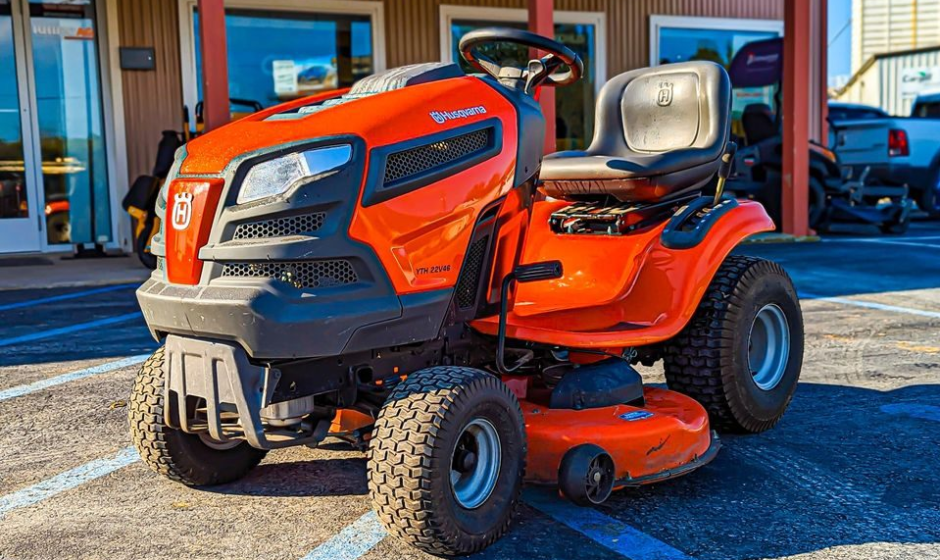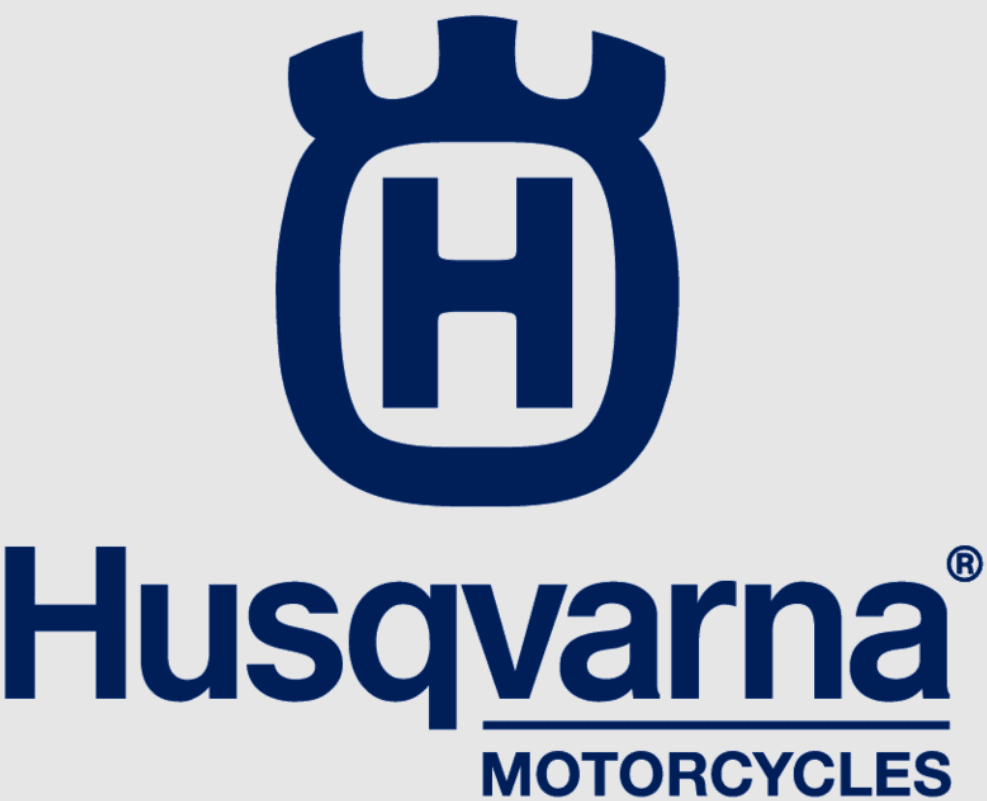
Husqvarna YTH22V46 Lawn Mower
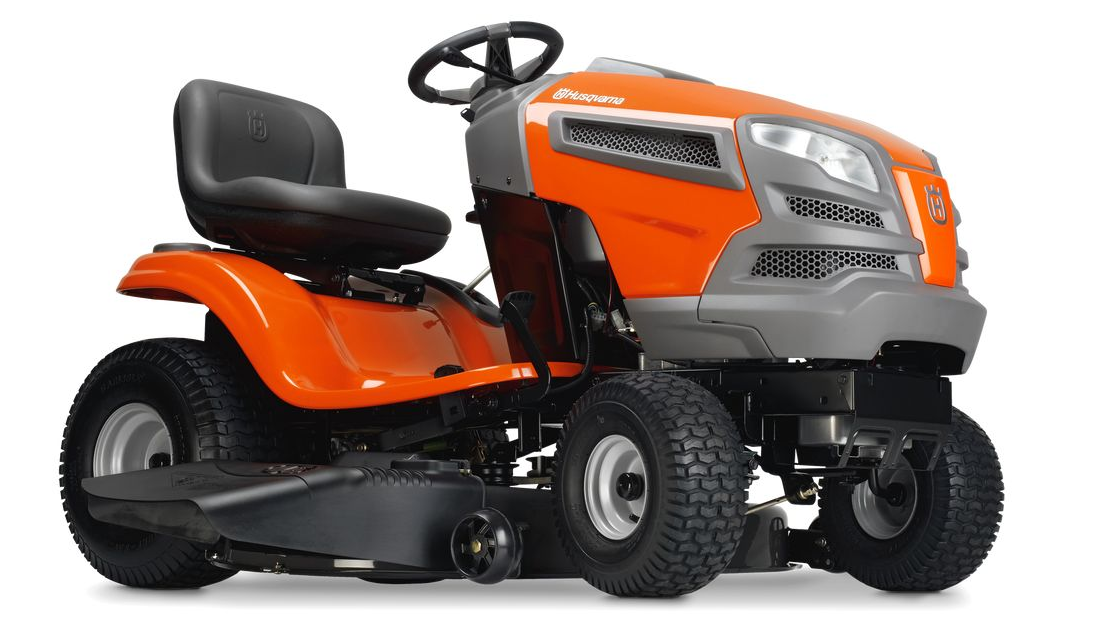
SAFETY RULES
Safe Operation Practices for Ride-On Mowers
GENERAL SERVICE
- Never operate machine in a closed area.
- Keep all nuts and bolts tight to be sure the equipment is in safe working condition.
- Never tamper with safety devices. Check their proper operation regularly.
- Keep machine free of grass, leaves, or other debris build-up. Clean oil or fuel spillage and remove any fuelsoaked debris. Allow machine to cool before storing.
- If you strike a foreign object, stop and inspect the machine. Repair, if necessary, before restarting.
- Never make any adjustments or repairs with the engine run ning.
- Check grass catcher components and the discharge chute frequently and replace with manufacturer’s recommended parts, when necessary.
- Mower blades are sharp. Wrap the blade or wear gloves, and use extra caution when servicing them.
- Check brake operation frequently. Adjust and service as required.
- Maintain or replace safety and instruction labels, as necessary.

- Be sure the area is clear of bystanders before operating. Stop machine if anyone enters the area.
- Never carry passengers.
- Do not mow in reverse unless absolutely necessary. Al ways look down and behind before and while backing.
- Never carry children, even with the blades shut off. They may fall off and be seriously injured or interfere with safe machine operation. Children who have been given rides in the past may suddenly appear in the mowing area for another ride and be run over or backed over by the machine.
- Keep children out of the mowing area and in the watchful care of a responsible adult other than the operator.
- Be alert and turn machine off if a child enters the area.
- Before and while backing, look behind and down for small children.
- Mow up and down slopes (15° Max), not across.
- Choose a low ground speed so that you will not have to stop or shift while on the slope.
- Avoid starting, stopping, or turning on a slope. If the tires lose traction, disengage the blades and proceed slowly straight down the slope.
- If machine stops while going uphill, disengage blades, shift into reverse and back down slowly.
- Do not turn on slopes unless necessary, and then, turn slowly and gradually downhill, if possible.
PRODUCT SPECIFICATIONS
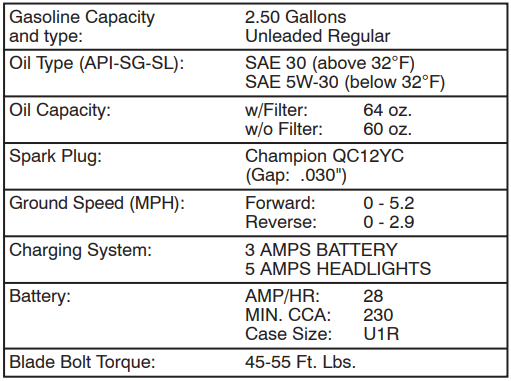
CONGRATULATIONS on your purchase of a new tractor. It has been designed, engineered and manufactured to give you the best possible dependability and performance. Should you experience any problem you cannot easily remedy, please contact your nearest authorized service center/ department We have competent, well-trained tech ni cians and the proper tools to service or repair this tractor.
Please read and retain this manual. The instructions will enable you to assemble and maintain your tractor properly. Always observe the “SAFETY RULES”.
CUSTOMER RESPONSIBILITIES
- Read and observe the safety rules.
- Follow a regular schedule in maintaining, caring for, and using your tractor.
- Follow the instructions under the “Maintenance” and “Storage” sections of this owner’s manual.
WARNING: This tractor is equipped with an internal combustion engine and should not be used on or near any unimproved forest-covered, brush-covered or grass-covered land unless the en gine’s exhaust system is equipped with a spark arrester meeting applicable local or state laws (if any). If a spark arrester is used, it should be maintained in effective working order by the operator.
In the state of California the above is required by law (Section 4442 of the California Public Resources Code). Other states may have similar laws. Federal laws apply on federal lands.
A spark arrester for the muffler is available through your nearest authorized service center/department (See RE PAIR PARTS section of this manual).
UNASSEMBLED PARTS

ASSEMBLY
Your new tractor has been assembled at the factory with the exception of those parts left unassembled for shipping purposes.
TOOLS REQUIRED FOR ASSEMBLY
A socket wrench set will make assembly easier. Stan dard wrench sizes are listed.
- 1/2″ wrench Tire pressure gauge
- 7/16″ wrenches Utility knife Pliers
When right or left hand is mentioned in this manual, it means when you are in the operating position (seated be hind the steer ing wheel).
TO REMOVE the TRACTOR FROM the carton, UNPACK the carton.
- Remove all accessible loose parts and parts cartons from carton .
- Cut along dotted lines on all four panels of carton. Remove end panels and lay side panels flat.
- Check for any additional loose parts or cartons and remove.
BEFORE REMOVING THE TRACTOR FROM SKID
TO CHECK BATTERY (See Fig. 1)
- Lift seat to raised position.
NOTE: If this battery is put into service after month and year indicated on label (label is located between terminals) charge battery for minimum of one hour at 6-10 amps. (See “BATTERY” in Maintenance section of this manual for charging instructions). - For battery and battery cable installation, see “REPLACING BATTERY” in the “Service and Adjustments” section in this manual.
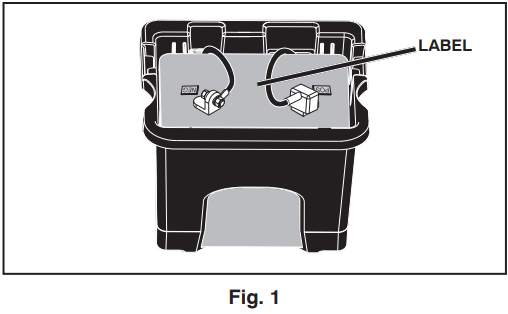
ADJUST SEAT (See Fig. 2)
- Sit in seat.
- Lift up adjustment lever (A) and slide seat until a comfortable position is reached which allows you to press clutch/brake pedal all the way down.
- Release lever to lock seat in position.
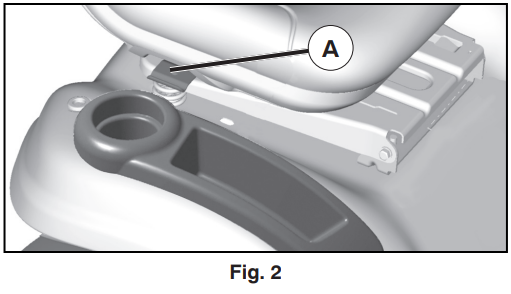
NOTE: You may now roll your tractor off the skid. Follow the instructions below to remove the tractor from the skid.
WARNING: Before start ing, read, un der stand and fol low all in struc tions in the Op er a tion section of this man u al. Be sure tractor is in a well-ventilated area. Be sure the area in front of tractor is clear of other peo ple and objects.
TO ROLL THE TRACTOR OFF THE SKID
(See Op er a tion section for location and function of con trols)
- Raise attachment lift lever to its highest position.
- Release parking brake by de press ing clutch/brake ped al.
- Place freewheel control in “trans mis sion dis en gaged” position (See “TO TRANS PORT” in the Op er a tion section of this manual).
- Roll tractor forward off skid.
- Remove banding holding the deflector shield up against tractor.
Continue with the instructions that follow.
CHECK TIRE PRESSURE
The tires on your tractor were overinflated at the factory for shipping purposes. Correct tire pressure is important for best cutting performance.
- Reduce tire pressure to PSI shown on tires.
CHECK DECK LEVELNESS
For best cutting results, mower housing should be properly leveled. See “TO LEVEL MOWER HOUSING” in the Service and Adjustments section of this manual.
CHECK FOR PROPER POSITION OF ALL BELTS
See the figures that are shown for replacing motion and mower blade drive belts in the Service and Adjustments sec tion of this manual. Verify that the belts are routed cor rect ly.
CHECK BRAKE SYSTEM
After you learn how to operate your tractor, check to see that the brake is operating properly. See “TO CHECK BRAKE” in the Service and Adjustments section of this manual.
✓CHECKLIST
BEFORE YOU OPERATE YOUR NEW TRAC TOR, WE WISH TO ASSURE THAT YOU RECEIVE THE BEST PERFORMANCE AND SATISFACTION FROM THIS QUALITY PRODUCT.
PLEASE REVIEW THE FOLLOWING CHECKLIST:
- ✓ All assembly instructions have been com plet ed.
- ✓ No remaining loose parts in carton.
- ✓ Battery is properly prepared and charged.
- ✓ Seat is adjusted comfortably and tightened securely.
- ✓ All tires are properly inflated. (For shipping purposes, the tires were overinflated at the factory).
- ✓ Be sure mower deck is properly leveled side-to-side/ front-to-rear for best cutting results. (Tires must be properly inflated for leveling).
- ✓ Check mower and drive belts. Be sure they are routed properly around pulleys and inside all belt keepers.
- ✓ Check wiring. See that all connections are still secure and wires are properly clamped.
- ✓ Before driving tractor, be sure free wheel control is in “transmission engaged” position (see “TO TRANSPORT” in the Operation section of this man u al).
WHILE LEARNING HOW TO USE YOUR TRACTOR, PAY EXTRA ATTENTION TO THE FOLLOWING IMPORTANT ITEMS:
- ✓ Engine oil is at proper level.
- ✓ Fuel tank is filled with fresh, clean, regular unleaded gasoline.
- ✓ Become familiar with all controls, their location and function. Operate them before you start the engine.
- ✓ Be sure brake system is in safe operating condition.
- ✓ Be sure Operator Presence System and Reverse Operation System (ROS) are working properly (See the Operation and Maintenance sections in this manual).
- ✓ It is important to purge the transmission before op er rating your tractor for the first time. Follow proper starting and transmission purging instructions (See “TO START EN GINE” and “PURGE TRANSMISSION” in the Op er a tion section of this manual).
OPERATION
These symbols may appear on your tractor or in literature supplied with the product. Learn and understand their meaning.
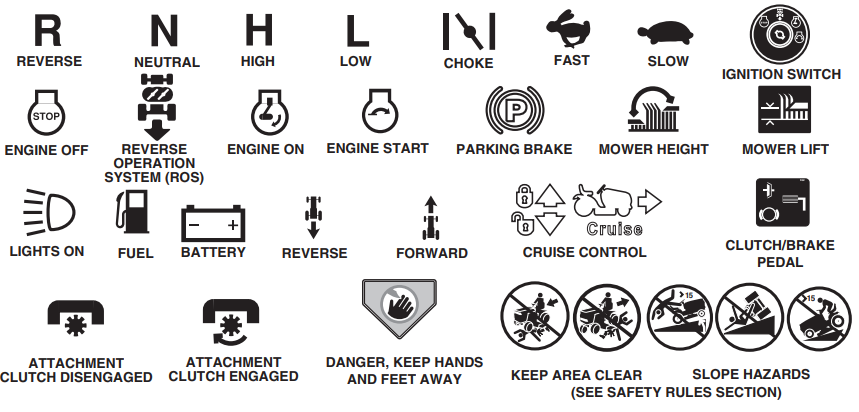
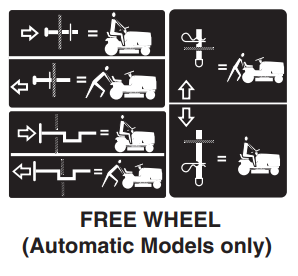
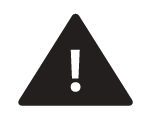
Failure to follow instructions could result in serious injury or death. The safety alert symbol is used to identify safety information about hazards which can result in death, serious injury and/or property damage.
![]() DANGER indicates a hazard which, if not avoided, will result in death or serious injury.
DANGER indicates a hazard which, if not avoided, will result in death or serious injury.
![]() WARNING indicates a hazard which, if not avoided, could result in death or serious injury.
WARNING indicates a hazard which, if not avoided, could result in death or serious injury.
![]() CAUTION indicates a hazard which, if not avoided might result in minor or moderate injury.
CAUTION indicates a hazard which, if not avoided might result in minor or moderate injury.
![]() CAUTION when used without the alert symbol, indicates a situation that could result in damage to the tractor and/or engine.
CAUTION when used without the alert symbol, indicates a situation that could result in damage to the tractor and/or engine.
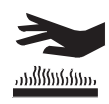 HOT SURFACES indicates a hazard which, if not avoided, could result in death, serious injury and/or property damage.
HOT SURFACES indicates a hazard which, if not avoided, could result in death, serious injury and/or property damage.
 FIRE indicates a hazard which, if not avoided, could result in death, serious injury and/or property damage.
FIRE indicates a hazard which, if not avoided, could result in death, serious injury and/or property damage.
KNOW YOUR TRACTOR
READ THIS OWNER’S MANUAL AND SAFETY RULES BEFORE OPERATING YOUR TRACTOR
Compare the illustrations with your tractor to familiarize yourself with the locations of various controls and ad just ments. Save this manual for future reference.
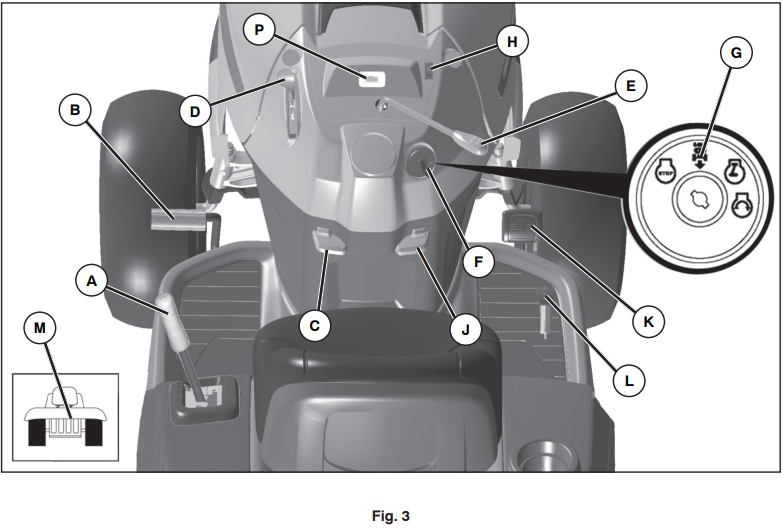
Our tractors conform to the applicable safety standards of the American National Standards Institute.
- (A) ATTACHMENT LIFT LEVER – Used to raise and lower the mower or other attachments mounted to your trac tor.
- (B) BRAKE PEDAL – Used for brak ing the tractor and start ing the engine.
- (C) PARKING BRAKE – Locks clutch/brake pedal into the brake position.
- (D) THROTTLE/CHOKE CONTROL – Used for starting and controlling engine speed.
- (E) ATTACHMENT CLUTCH LEVER – Used to engage the mow er blades, or other at tach ments mounted to your tractor.
- (F) IGNITION SWITCH – Used for starting and stopping the engine.
- (G) REVERSE OPERATION SYSTEM (ROS) “ON” POSITION – Allows operation of mower or other powered attachment while in reverse.
- (H) LIGHT SWITCH – Turns the headlights on and off.
- (J) CRUISE CONTROL LEVER – Used to set forward movement of tractor at desired speed without holding the forward drive pedal.
- (K) FORWARD DRIVE PEDAL – Used for forward movement of tractor.
- (L) REVERSE DRIVE PEDAL – Used for reverse movement of tractor.
- (M) FREEWHEEL CONTROL – Disengages transmission for pushing or slowly tow ing the trac tor with the engine off.
- (P) SERVICE REMINDER / HOUR METER – Indicates when service is required for the engine and mower.
HOW TO USE YOUR TRAC TOR
TO SET PARKING BRAKE (See Fig. 4)
Your tractor is equipped with an operator presence sensing switch. When engine is running, any attempt by the op er a tor to leave the seat without first setting the parking brake will shut off the engine.
- Depress brake pedal (B) all the way down and hold.
- Pull parking brake lever (C) up and hold, re lease pressure from brake pedal (B), then release parking brake lever. Pedal should re main in brake position. Make sure parking brake will hold tractor secure.
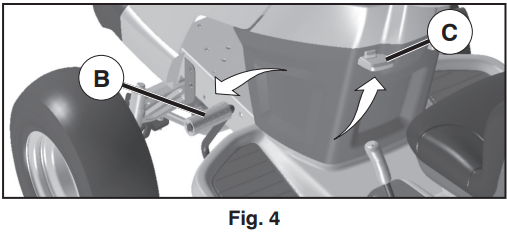
STOPPING (See Fig. 5)
MOWER BLADES –
- To stop mower blades, place attachment clutch control in the “DISENGAGED” position
 .
.
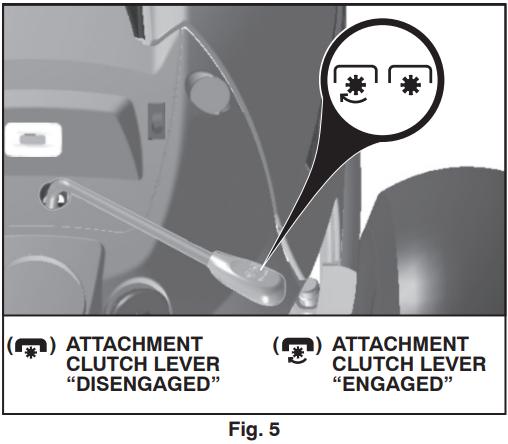
GROUND DRIVE –
- To stop ground drive, depress brake pedal into full “BRAKE” position.
IMPORTANT: FORWARD AND REVERSE DRIVE PEDALS RETURN TO NEUTRAL POSITION WHEN NOT DEPRESSED.
ENGINE –
- Move throttle control (D) between half and full speed (fast) position.
NOTE: Failure to move throttle control between half and full speed (fast) position, before stop ping may cause engine to “backfire”. - Turn ignition key (F) to “STOP” position and remove key. Always remove key when leaving tractor to prevent un author ized use.
- Never use the choke to stop the engine.
IMPORTANT: LEAVING THE IGNITION SWITCH IN ANY POSITION OTHER THAN “STOP” WILL CAUSE THE BATTERY TO BE DIS CHARGED, (DEAD).
NOTE: Under certain conditions when tractor is standing idle with the engine running, hot en gine exhaust gases may cause “browning” of grass. To eliminate this possibility, always stop engine when stopping tractor on grass areas.
![]() CAUTION: Always stop tractor completely, as described above, and set parking brake before leav ing the op er ator’s position.
CAUTION: Always stop tractor completely, as described above, and set parking brake before leav ing the op er ator’s position.
TO USE THROTTLE CONTROL (D) (See Fig. 6)
Always operate engine at full speed (fast).
- Operating engine at less than full speed (fast) reduces the engine’s operating efficiency.
- Full speed (fast) of fers the best mower per for mance.
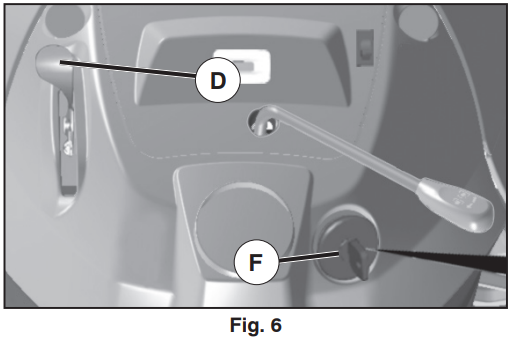
TO MOVE FORWARD AND BACKWARD (See Fig. 7)
The direction and speed of movement is controlled by the forward and reverse drive pedals.
- Start tractor and release parking brake.
- Slowly depress forward (K) or reverse (L) drive pedal to begin movement. Ground speed increases the further down the pedal is depressed.
TO USE CRUISE CONTROL (J) (See Fig. 7)
The cruise control feature can be used for forward travel only.
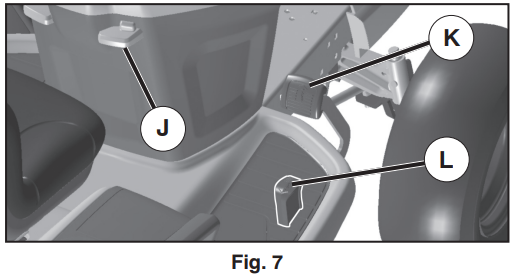
SYSTEM CHARACTERISTICS
The cruise control should only be used while mowing or transporting on relatively smooth, straight surfaces. Other con di tions such as trimming at slow speeds may cause the cruise control to dis en gage. Do not use the cruise control on slopes, rough terrian or while trimmimg or turning.
- With forward drive pedal depressed to desired speed, pull cruise control lever (J) up and hold while lifting your foot off the pedal, then release the lever.
To disengage the cruise control, depress the brake pedal or tap on forward drive pedal.
TO ADJUST MOWER CUT TING HEIGHT (See Fig. 8)
The position of the at tach ment lift le ver (A) de ter mines the cut ting height.

- Put attachment lift lever in desired cutting height slot.
The cutting height range is ap prox i mate ly 1″ to 4″. The heights are measured from the ground to the blade tip with the engine not running. These heights are approximate and may vary depending upon soil conditions, height of grass and types of grass being mowed. - The average lawn should be cut to approximately 2-1/2 ” during the cool season and to over 3″during hot months. For healthier and better looking lawns, mow often and after moderate growth.
- For best cutting performance, grass over 6″ in height should be mowed twice. Make the first cut relatively high; the second to de sired height.
TO ADJUST GAUGE WHEELS (See Fig. 9)
Gauge wheels are prop er ly ad just ed when they are slight ly off the ground when mower is at the desired cutting height in operating position. Gauge wheels then keep the deck in proper position to help prevent scalping in most terrain conditions.
NOTE: Adjust gauge wheels with tractor on a flat level surface.
- Adjust mower to desired cutting height (See “TO ADJUST MOWER CUT TING HEIGHT” in this sec tion of manual).
- With mower in desired height of cut po si tion, gauge wheels should be assembled so they are slightly off the ground. In stall gauge wheel in ap pro pri ate hole. Tighten se curely.
- Repeat for all, installing gauge wheel in same adjustment hole.
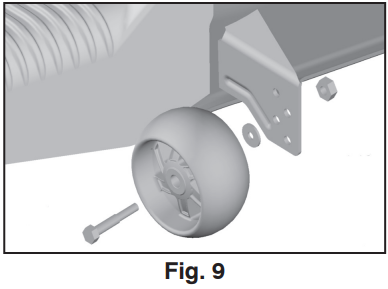
TO OPERATE MOWER
Your tractor is equipped with an operator presence sensing switch. Any attempt by the operator to leave the seat with the engine running and the attachment clutch engaged will shut off the engine. You must remain fully and centrally positioned in the seat to prevent the engine from hesitating or cutting off when operating your equipment on rough, rolling terrain or hills.
- Select desired height of cut (see “TO ADJUST MOWER CUTTING HEIGHT”)
- Start mower blades by engaging at tach ment clutch control.
TO STOP MOWER BLADES
- Disengage at tach ment clutch con trol.
![]() CAUTION: Do not operate the mower without either the en tire grass catcher, on mowers so equipped, or the deflector shield (S) in place (See Fig. 10).
CAUTION: Do not operate the mower without either the en tire grass catcher, on mowers so equipped, or the deflector shield (S) in place (See Fig. 10).
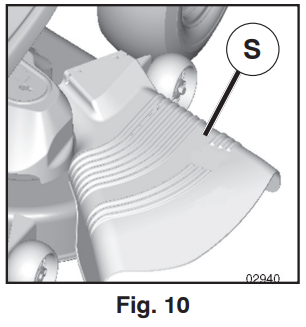
REVERSE OPERATION SYSTEM (ROS)
Your tractor is equipped with a Reverse Operation System (ROS). Any attempt by the operator to travel in the reverse direction with the attachment clutch engaged will shut off the engine unless ignition key is placed in the ROS “ON” position.
![]() WARNING: Backing up with the attachment clutch engaged while mowing is strongly discouraged. Turning the ROS “ON”, to allow reverse operation with the attachment clutch engaged, should only be done when the operator decides it is necessary to reposition the machine with the attachment engaged. Do not mow in reverse unless absolutely necessary.
WARNING: Backing up with the attachment clutch engaged while mowing is strongly discouraged. Turning the ROS “ON”, to allow reverse operation with the attachment clutch engaged, should only be done when the operator decides it is necessary to reposition the machine with the attachment engaged. Do not mow in reverse unless absolutely necessary.
USING THE REVERSE OPERATION SYSTEM –
Only use if you are certain no children or other bystanders will enter the mowing area.
- Depress brake pedal all the way down.
- With engine running, turn ignition key counterclockwise to ROS “ON” position.
- Look down and behind before and while backing.
- Slowly depress reverse drive pedal to start movement.
- When use of the ROS is no longer needed, turn the ignition key clockwise to engine “ON” position.
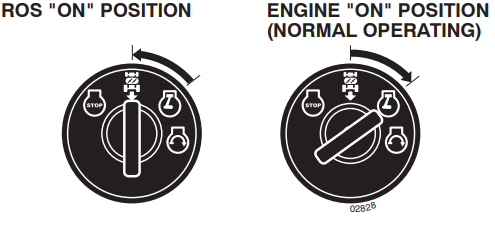
TO OPERATE ON HILLS
![]() CAUTION: Do not drive up or down hills with slopes greater than 15° and do not drive across any slope.
CAUTION: Do not drive up or down hills with slopes greater than 15° and do not drive across any slope.
- Choose the slowest speed before starting up or down hills.
- Avoid stopping or changing speed on hills.
- If stopping is absolutely necessary, push brake pedal quickly to brake position and engage parking brake.
- To restart movement, slowly release parking brake and brake pedal.
- Slowly depress appropriate drive pedal to slowest setting.
- Make all turns slowly.
TO TRANSPORT (See Figs. 3 and 11)
When pushing or towing your tractor, be sure to disengage transmission by placing freewheel control in free wheel ing po si tion. Free wheel control is located at the rear drawbar of tractor.
- Raise attachment lift to highest position with at tach meant lift control.
- Pull freewheel control out and down into the slot and release so it is held in the disengaged position.
- Do not push or tow tractor at more than two (2) MPH.
- To reengage transmission, reverse above procedure.
NOTE: To protect hood from damage when transporting your tractor on a truck or a trailer, be sure hood is closed and secured to tractor. Use an appropriate means of tying hood to tractor (rope, cord, etc.).
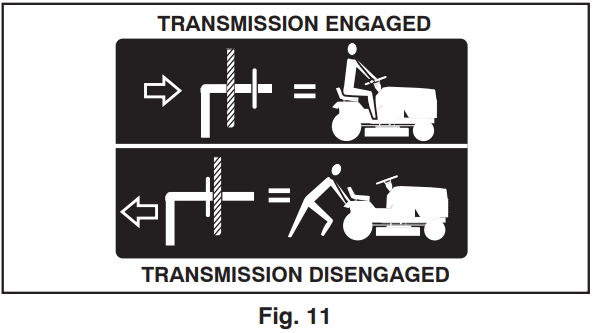
TOWING CARTS AND OTHER AT TACH MENTS
Tow only the attachments that are recommended by and comply with specifications of the manufacturer of your tractor. Use common sense when towing. Too heavy of a load, while on a slope, is dangerous. Tires can lose traction with the ground and cause you to lose control of your tractor.
SERVICE REMINDER/HOUR METER
Service reminder shows the total number of hours the engine has run and flashes to indicate that the engine or mower needs servicing. When service is required, the service reminder will flash for two hours. To service engine and mower, see the Maintenance section of this manual.
NOTE: Service reminder runs when the ignition key is in any position but “STOP”. For accurate reading, be sure key remains in the “STOP” position when engine is not running.
TROUBLESHOOTING
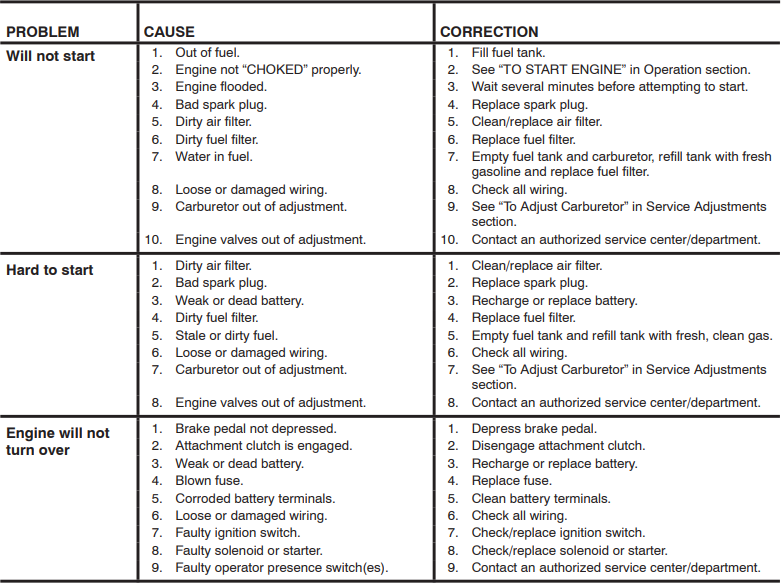
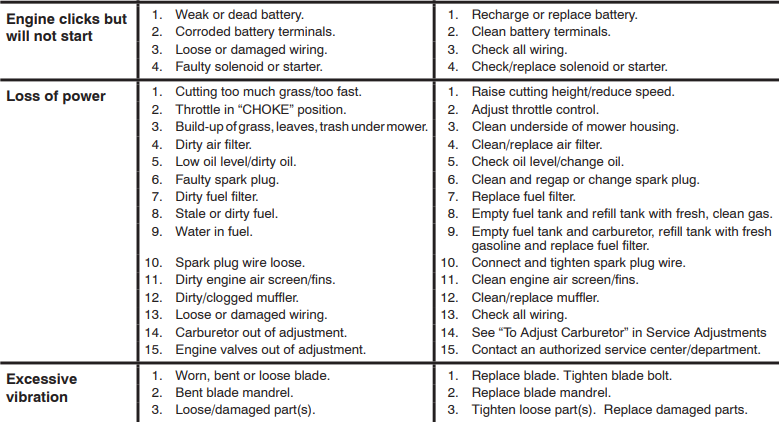
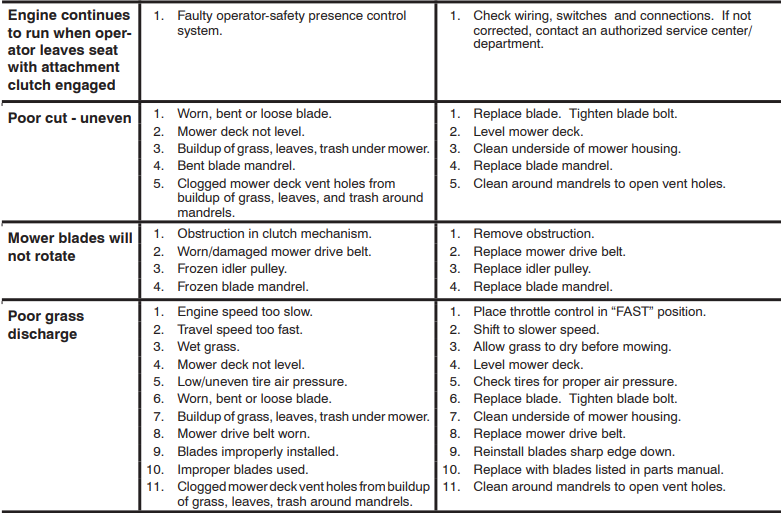
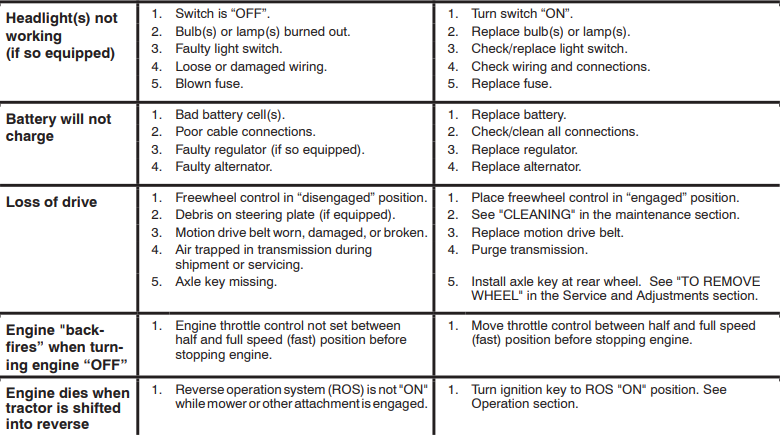
For more manuals by Husqvarna, visit ManualsLibraryy
Husqvarna YTH22V46 Lawn Mower- FAQs
How much oil does the YTH22V46 take?
The YTH22V46 requires approximately 48–64 oz (1.4–1.9 L) of SAE 30 or 10W-30 oil (check the manual for exact capacity). Always use the dipstick to verify levels.
How do I start the YTH22V46?
Sit on the seat (safety switch requires weight).
Set the parking brake.
Move the throttle to “Fast” (rabbit symbol).
Turn the key to “Start.”
What engine does the YTH22V46 have?
A 22 HP Briggs & Stratton® Intek V-Twin engine with hydrostatic transmission for smooth speed control.
What are common problems with Husqvarna riding mowers?
Won’t start (check fuel, battery, spark plug).
Stalls after starting (dirty air/fuel filter, bad gas).
Battery dies (faulty alternator or old battery).
Leaks gas (cracked fuel line or tank).
Smoking (overfilled oil or engine overheating).
How do I unlock the mower?
Use the Husqvarna Connect app → Select mower → Tap “Unlock.”
Does it have electric start?
Yes, the YTH22V46 features a key-start ignition (no pull cord).
How do I freewheel the hydrostatic transmission?
Locate the freewheel lever (near rear wheels) and pull it back to manually push the mower.
Can I mulch with the YTH22V46?
Yes! Install a mulch kit (sold separately) to convert the mower for mulching grass clippings.
What’s the towing capacity?
620 lbs – suitable for small trailers or yard carts.

